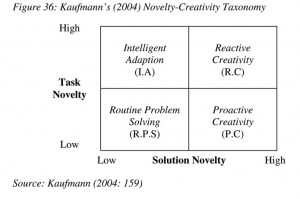Sep 4, 2009
Two Views of the Creative Product
Two Views of the Creative Product
1) A Novelty-Creativity Taxonomy
Kaufmann (2004) attempts to distinguish between ‘mere’ intelligence and creativity by proposing a model that views creativity in terms novelty on the level of both task and product – Figure 36 represents the proposed model. Implicitly all the acts classified by this taxonomy have value as they are described as solutions to problems.
Figure 36: Kaufmann’s (2004) Novelty-Creativity Taxonomy
For Kaufmann, creative acts are not wholly the products of rigid personality traits, but rather a function of situational and outcome factors – the novelty of the solution and the task. Creativity in the context of this model implies high novelty on the solution side, with the degree of novelty on the task side determining whether the act is reactively creative (high task novelty) (upper right quadrant of Figure 36) or proactively creative (low task novelty) (lower right quadrant of Figure 36).
The characteristics of Kaufmann’s ‘pro/reactive creativity’ are similar to those described by Brinck (1997)’s model of creativity as a special kind of problem solving.
In Brinck’s description, due to the fact that “one cannot get to the solution using the available tools” (Brinck, 1997: 7) task novelty is high for creative acts (reactive creativity). Furthermore, solution novelty is high because when the creative agent is not satisfied with expected solutions (routine problem solving (lower left quadrant of Figure 36) or intelligent adaption (upper left quadrant of Figure 36)), looking for solutions that lead him down new pathways to unexpected and/or new outcomes.
This model provides a framework for classifying acts as routine, intelligent or creative and placing them in a context of ‘usefulness’ to the firm. Further, such a model may aid the identification of the kind of act needed to achieve a desired outcome in a given context – thus informing policy formulation in the organisation.
2) Combinational and Conceptual Creativity
Boden (1997) distinguishes between ‘combinational’ and ‘conceptual’ creativity – the former involving interesting arrangements or combinations of familiar ideas (e.g. analogy or poetry), the latter implying a change in a cognitive space – conceptually, knowledge and the constraints it implies is central to both these forms.
Combinational creativity is the least constrained (it is easy to throw together random concepts to produce ‘novel’ ideas) of the two, but requires a large degree of discipline and skill in order to produce a valuable and elegant product (thus fitting the criteria of creativity).
In order to discuss ‘conceptual’ creativity, it is first necessary to set out what is meant by a ‘cognitive space’ (Boden, 1997). Cognitive spaces are styles of thinking (or generative constraints) and she notes that such spaces are ‘positive constraints’ in that they impact on what may be thought, as opposed to what may not be thought.
Nonetheless such spaces are constricting due to the fact that ‘unthinkable thoughts’ (new ideas) remain nonsense unless the conceptual space can be changed (in a superficial or fundamental way) in order to allow them to be thought (Boden, 1997).
If such a change is to take place it must be accepted (evaluated and then valued) within its context, and for this to happen knowledge is essential in order to judge and mould the space changing idea into a valuable concept.
Such expert knowledge allows:
- The evaluation and application of the dropping/changing of constraints within the conceptual space,
- Easier navigation of the transformed conceptual space (making it more intelligible and thus less likely to be rejected off-hand), and
- The evaluation of “the novel result of applying the transformational heuristic” (Boden, 1997: 3).
In this way a link is drawn between the possession of knowledge (and the constraints that come with it) and real creativity (as opposed to the random generation of ‘novel’ ideas) (Boden, 1997; Brinck, 1997).
References:
Boden, M.A. (1997). The constraints of knowledge. In Å.E. Andersson and N.E. Sahlin (eds.) The complexity of creativity, 1-4. Dordrecht: Kulwer Academic Publishers.
Brinck, I. (1997). The gist of creativity. In Å.E. Andersson and N.E. Sahlin (eds). The complexity of creativity, 5-16. Dordrecht: Kulwer Academic Publishers.

